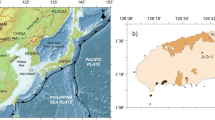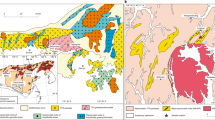Abstract
Application of the 147Sm–143Nd chronometer (half-life of 106?Gyr) suggests that large-scale differentiation of the Earth's mantle may have occurred during the first few hundred million years of its history1. However, the signature of mantle depletion found in early Archaean rocks is often obscured by uncertainties resulting from open-system behaviour of the rocks during later high-grade metamorphic events2. Hence, although strong hints exist regarding the presence of differentiated silicate reservoirs before 4.0?Gyr ago, both the nature and age of early mantle differentiation processes remain largely speculative3,4,5. Here we apply short-lived 146Sm–142Nd chronometry (half-life of 103?Myr) to early Archaean rocks using ultraprecise measurement of Nd isotope ratios. The analysed samples are well-preserved metamorphosed sedimentary rocks from the 3.7–3.8-Gyr Isua greenstone belt of West Greenland. Our coupled isotopic calculations, combined with an initial ɛ143Nd value from ref. 6, constrain the mean age of mantle differentiation to 4,460 ± 115?Myr. This early Sm/Nd fractionation probably reflects differentiation of the Earth's mantle during the final stage of terrestrial accretion.
This is a preview of subscription content, access via your institution
Access options
Subscribe to this journal
Receive 51 print issues and online access
$199.00 per year
only $3.90 per issue
Buy this article
- Purchase on Springer Link
- Instant access to full article PDF
Prices may be subject to local taxes which are calculated during checkout



Similar content being viewed by others
References
Smith, A. D. & Ludden, J. N. Nd isotopic evolution of the Precambrian mantle. Earth Planet. Sci. Lett. 93, 14–22 (1989)
Moorbath, S., Whitehouse, M. J. & Kamber, B. S. Extreme Nd-isotope heterogeneity in the early Archaean—fact or fiction? Case histories from northern Canada and West Greenland. Chem. Geol. 135, 213–231 (1997)
Armstrong, R. L. Radiogenic isotopes: The case for crustal recycling on a near-steady-state no-continent-growth Earth. Phil. Trans. R. Soc. Lond. A 301, 443–472 (1981)
Chase, C. G. & Patchett, P. J. Stored mafic/ultramafic crust and early Archean mantle depletion. Earth Planet. Sci. Lett. 91, 66–72 (1988)
Galer, S. J. G. & Goldstein, S. L. Early mantle differentiation and its thermal consequences. Geochim. Cosmochim. Acta 55, 227–239 (1991)
Kamber, B. S., Moorbath, S. & Whitehouse, M. J. Extreme Nd isotope heterogeneity in the early Archean—fact of fiction? Case histories from northern Canada and West Greenland—Reply. Chem. Geol. 148, 219–224 (1998)
Allègre, C. J., Staudacher, T. & Sarda, P. Rare gas systematics: Formation of the atmosphere, evolution and structure of the Earth's mantle. Earth Planet. Sci. Lett. 81, 127–150 (1986)
Yin, Q. et al. A short timescale for terrestrial planet formation from Hf–W chronometry of meteorites. Nature 418, 949–952 (2002)
Kleine, T., Münker, C., Mezger, K. & Palme, H. Rapid accretion and early core formation on asteroids and the terrestrial planets from Hf–W chronometry. Nature 418, 952–955 (2002)
Schoenberg, R., Kamber, B. S., Collerson, K. D. & Eugster, O. New W-isotope evidence for rapid terrestrial accretion and early core formation. Geochim. Cosmochim. Acta 66, 3151–3160 (2002)
Lugmair, G. W., Shimamura, T., Lewis, R. S. & Anders, E. Samarium-146 in the early Solar System: Evidence from neodymium in the Allende meteorite. Science 222, 1015–1018 (1983)
Prinzhofer, D. A., Papanastassiou, D. A. & Wasserburg, G. J. Samarium-neodymium evolution of meteorites. Geochim. Cosmochim. Acta 56, 797–815 (1992)
Sharma, M., Papanastassiou, D. A., Wasserburg, G. J. & Dymek, R. F. The issue of the terrestrial record of 146Sm. Geochim. Cosmochim. Acta 60, 2037–2047 (1996)
Harper, C. L. & Jacobsen, S. B. Evidence from coupled 147Sm–143Nd and 146Sm–142Nd systematics for very early (4.5?Gyr) differentiation of the Earth's mantle. Nature 360, 728–732 (1992)
Goldstein, S. L. & Galer, S. J. G. On the trail of early mantle differentiation: 142Nd/144Nd ratios of early Archean rocks. Eos 73, 323 (1992)
McCulloch, M. T. & Bennett, V. C. Evolution of the early Earth: Constraints from 143Nd-142Nd isotopic systematics. Lithos 30, 234–255 (1993)
Regelous, M. & Collerson, K. D. 147Sm-143Nd, 146Sm-142Nd systematics of early Archaean rocks and implications for crust-mantle evolution. Geochim. Cosmochim. Acta 60, 3513–3520 (1996)
Caro, G., Bourdon, B., Birck, J. L. & Moorbath, S. 142Nd/144Nd precise determination in early Archean rocks. [Abstract]. Geochim. Cosmochim. Acta 66, A121 (2002)
Boyet, M., Albarède, F., Télouk, P. & Rosing, M. 142Nd anomaly confirmed at Isua. [Abstract]. Geochim. Cosmochim. Acta 66, A99 (2002)
Boak, J. L. & Dymek, R. F. Metamorphism of the ca. 3800?Ma supracrustal rocks at Isua, West Greenland: Implications for early Archaean crustal evolution. Earth Planet. Sci. Lett. 59, 155–176 (1982)
Nutman, A. P., Bennett, V. C., Friend, C. R. L. & Rosing, M. T. 3710 and >3790?Ma volcanic sequences in the Isua (Greenland) greenstone belt; structural and Nd isotope implications. Chem. Geol. 141, 271–287 (1997)
Schoenberg, R., Kamber, B. S., Collerson, K. D. & Moorbath, S. Tungsten isotope evidence from 3.8-Gyr metamorphosed sediments for early meteorite bombardment of the Earth. Nature 418, 403–405 (2002)
Goldstein, S. J. & Jacobsen, S. B. Nd and Sr isotopic systematics of river water suspended material: Implications for crustal evolution. Earth Planet. Sci. Lett. 87, 249–265 (1988)
Hofmann, A. W. Chemical differentiation of the Earth: The relationship between mantle, continental crust, and oceanic crust. Earth Planet. Sci. Lett. 90, 297–314 (1988)
Chambers, J. E. Making more terrestrial planets. Icarus 152, 205–224 (2001)
Harper, C. L., Nyquist, L. E., Bansal, B., Wiesmann, H. & Shih, C. Rapid accretion and early differentiation of Mars indicated by 142Nd/144Nd in SNC meteorites. Science 267, 213–217 (1995)
Borg, L. E., Nyquist, L. E., Taylor, L. A., Wiesmann, H. & Shih, C. Constraints on Martian differentiation processes from Rb-Sr and Sm-Nd isotopic analyses of the basaltic shergottite QUE 94201. Geochim. Cosmochim. Acta 61, 4915–4931 (1997)
Tonks, B. T. & Melosh, H. J. Magma ocean formation due to giant impacts. J. Geophys. Res. 98, 5319–5333 (1993)
Choblet, G. & Sotin, C. 3D thermal convection with variable viscosity: Can transient cooling be described by a quasi-static scaling law? Phys. Earth Planet. Inter. 119, 321–336 (2000)
Vance, D. & Thirlwall, M. An assessment of mass discrimination in MC-ICPMS using Nd isotopes. Chem. Geol. 185, 227–240 (2002)
Rehkämper, M., Gärtner, M., Galer, S. J. G. & Goldstein, S. L. Separation of Ce from other rare-earth elements with application to Sm-Nd and La-Ce chronometry. Chem. Geol. 129, 201–208 (1996)
Acknowledgements
We thank C. Allègre, C. Jaupart and C. Langmuir for discussions, K. Burton for input at the earlier stage of this work, M. Delmotte for maintaining the TRITON in good condition, and M. Pierre for help with analytical chemistry. S.M. thanks P. Appel and the Isua Multidisciplinary Research Project for logistic and financial support of field work. This work was supported by the CNRS research programme ‘Intérieur de la Terre’.
Author information
Authors and Affiliations
Corresponding author
Ethics declarations
Competing interests
The authors declare that they have no competing financial interests.
Rights and permissions
About this article
Cite this article
Caro, G., Bourdon, B., Birck, JL. et al. 146Sm–142Nd evidence from Isua metamorphosed sediments for early differentiation of the Earth's mantle. Nature 423, 428–432 (2003). https://doi.org/10.1038/nature01668
Received:
Accepted:
Issue Date:
DOI: https://doi.org/10.1038/nature01668
This article is cited by
-
Magma Ocean, Water, and the Early Atmosphere of Venus
Space Science Reviews (2023)
-
The accretion of planet Earth
Nature Reviews Earth & Environment (2022)
-
Direct evidence for crust-mantle differentiation in the late Hadean
Communications Earth & Environment (2022)
-
Eoarchean subduction-like magmatism recorded in 3750 Ma mafic–ultramafic rocks of the Ukaliq supracrustal belt (Québec)
Contributions to Mineralogy and Petrology (2022)
-
A model of crust–mantle differentiation for the early Earth
Acta Geochimica (2022)
Comments
By submitting a comment you agree to abide by our Terms and Community Guidelines. If you find something abusive or that does not comply with our terms or guidelines please flag it as inappropriate.



